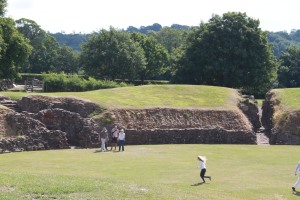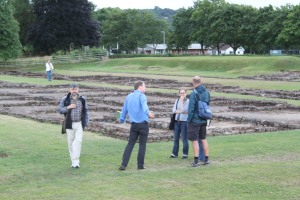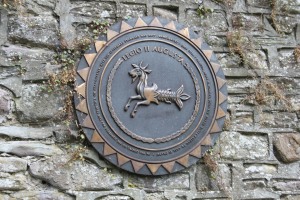In September 2013 the project team met at Caerleon. This post first appeared on Professor Howard William’s blog “Archaeodeath.”
The Past in its Place: The City of the Legions
The Roman Amphitheatre at Caerleon, once known as King Arthur’s Round Table.
I am working on a collaborative research project funded by the Leverhulme Trust and the European Research Council called ‘the Past in its Place’. As well as geographers, historians and literary scholars based at the University of Exeter, the project funds my PhD student – Ruth Nugent – who is working on death and memory over the long-term in cathedrals. The project is led by Professor Philip Schwyzer of the Department of English at the University of Exeter.
Yesterday, I attended a project meeting at one of our study sites: Caerleon. A series of resources about the history and archaeology of Caerleon can be found on Caerleon.net
Caerleon is well known to archaeologists as Isca – the legionary fortress of the II Augusta legion. The landscape of Caerleon has been subjected to many campaigns of excavation. Perhaps most famously, the great Sir Mortimer Wheeler excavated the amphitheatre – hitherto known as King Arthur’s Round Table.
The Past in its Place project team, exploring the Roman barracks
More recently, excavations by Dr Andy Gardner (UCL) and Dr Peter Guest (Cardiff University) have explored Roman warehouses at Priory Field between 2008 and 2010. Subsequently in 2011 Guest explored the Southern Cabanae, further adding to the understanding of the fortress and its immediate environs. These long-running excavation projects have added greatly to our understanding of Roman-period Caerleon.
Our project is interested in the pre-Roman context, Roman-period activity and subsequent archaeological, historical and literary engagements with the ruins and landscape of Caerleon. In this regard, we have been inspired by the work of Professor Ray Howell, who has written two fascinating articles on the medieval mnemonic and ideological engagements with the site.
An example of the commemoration of heritage- this plaque on the churchyard wall marks the centre of the principium of the legionary fortress.
So rather than exploring any particular period in Caerleon’s past, we are interested in the ‘history of memory’ of Caerleon. For instance, we want to explore the association with the early martyrs Julius, Aaron and perhaps also Alban, as well as St Cadoc and the fortress’s Arthurian and medieval romance associations. Rather than simply being interested in the literary ‘reception’ of Caerleon, we wish to explore how these ‘memories’ responded to, and engaged with, and manifest themselves in, the material culture, monuments and landscape of Caerleon to the present day. So we are taking the story up to the nineteenth and twentieth centuries, exploring the literary and archaeological engagements with this place of history and this place of myth. We are also interested in the heritage projection and consumption of these stories.
Our visit took in a look at the Roman walls, amphitheatre and barracks, the Roman baths, National Roman Legion Museum and the churchyard of St Cadoc’s. We then had a 4-hour intensive meeting sustained by superb sandwiches in the National Roman Legion Museum.
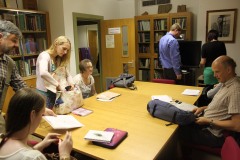
The nine gather in the library of the National Roman Legion Museum, Caerleon
‘Dave the Slave’ – the South Parkian mascot of the Roman Baths, Caerleon
Sitting in the meeting was an interesting experience. Despite being long-term collaborators, this was the first time that the nine of us had been present in the same room at the same time. It was a true gathering of the nine!
Also impressive was that our meeting with held in the library of the National Roman Legion Museum. Behind me on the wall was the memorial to one V.E. Nash-Williams, himself a great Welsh archaeologist and author of the Roman Frontier in Wales (1954) and the Early Christian Monuments of Wales (1950). I wonder what he would make of our discussions about Caerleon through the ages?
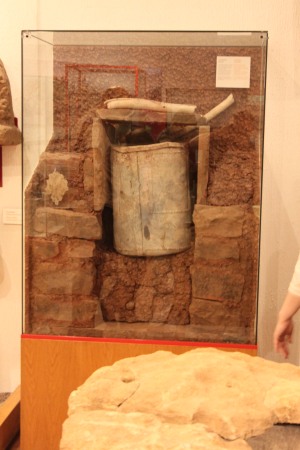 There are many fascinating Roman antiquities to be seen at Caerleon both outdoors and indoors in the museums. The Roman intaglios from the bath-house drain are my favourite among the small-finds. Yet if I were to pick a single display that is important for my research, it has to be the famous pipe-burial. This find was first published by Mortimer Wheeler in the Antiquaries Journal for 1929 and its display is simultaneously a striking example of Mediterranean imported mortuary practice taking place close to Roman-period Caerleon, but also a fascinating example of how it is possible to display cremated human remains in the museum and make the inert, silent artefacts speak of funerary process and the on-going dialogues between the living and the dead that resulted from the funeral.
There are many fascinating Roman antiquities to be seen at Caerleon both outdoors and indoors in the museums. The Roman intaglios from the bath-house drain are my favourite among the small-finds. Yet if I were to pick a single display that is important for my research, it has to be the famous pipe-burial. This find was first published by Mortimer Wheeler in the Antiquaries Journal for 1929 and its display is simultaneously a striking example of Mediterranean imported mortuary practice taking place close to Roman-period Caerleon, but also a fascinating example of how it is possible to display cremated human remains in the museum and make the inert, silent artefacts speak of funerary process and the on-going dialogues between the living and the dead that resulted from the funeral.
Yet the challenge for our project is to tackle the absence of the medieval heritage of Caerleon, the result of the keen interest in the Roman era and the difficulty of discerning clearly the character of the medieval use of the ruined fortress. Ultimately however, the conflation of the heritage of Caerleon to the Roman period is a conceit and one that creates a massive fifteen hundred year block of archaeological and heritage ‘forgetting’ for even the informed visitor to struggle against. It is this post-Roman heritage that our project aims to critically tackle.

